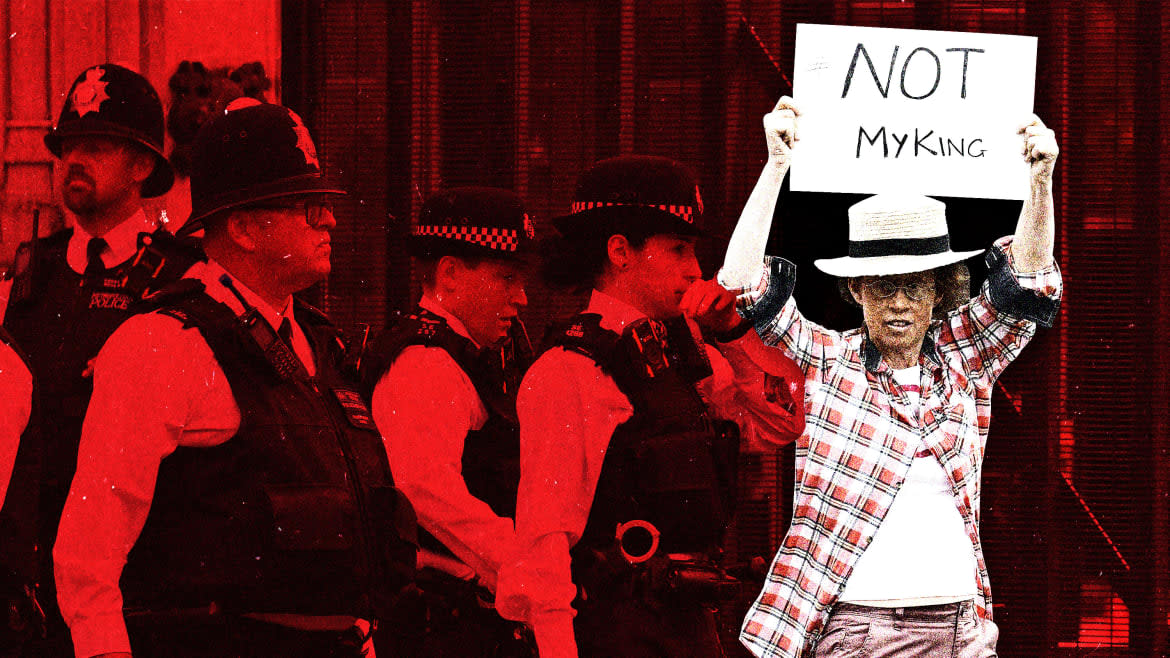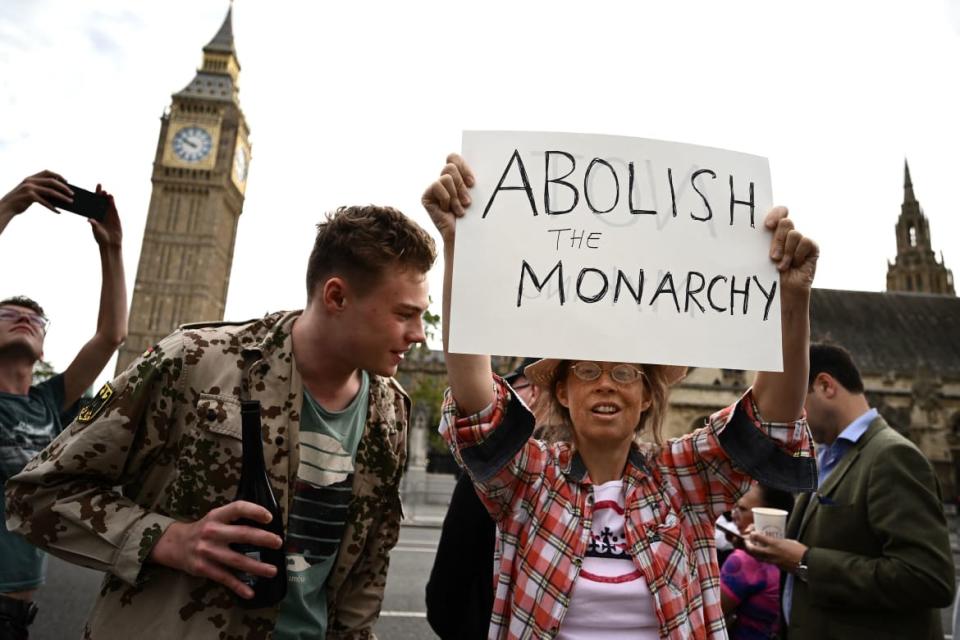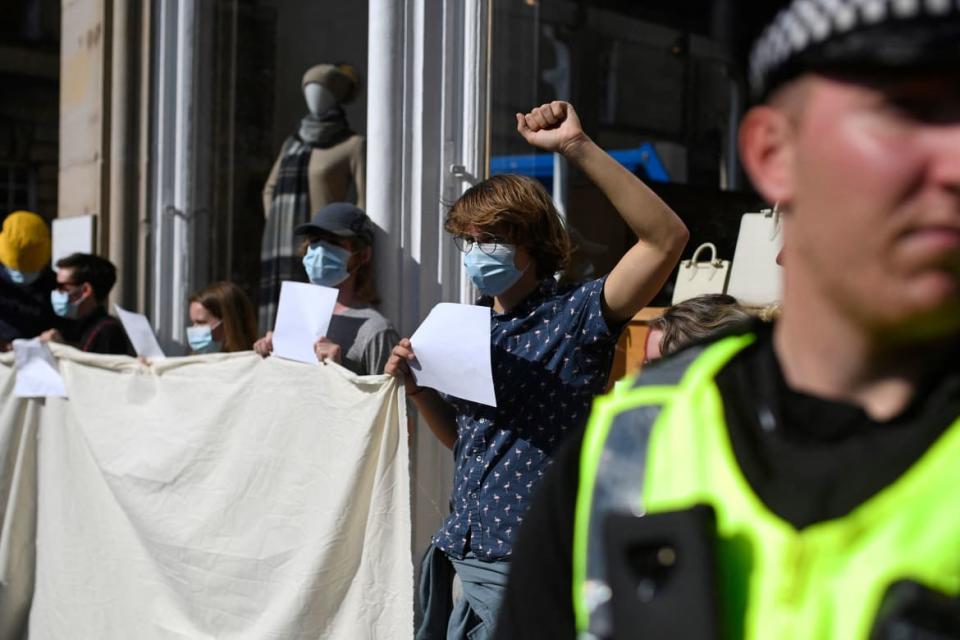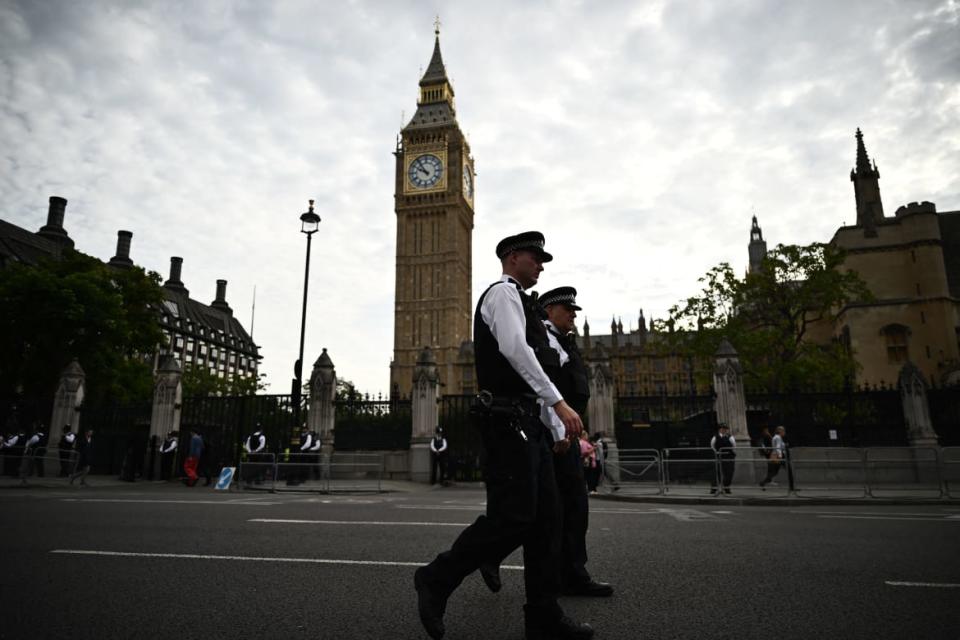U.K.’s Crackdown on Anti-Royal Protests Makes U.S. Free Speech Look Good

- Oops!Something went wrong.Please try again later.
- Oops!Something went wrong.Please try again later.
- Oops!Something went wrong.Please try again later.
- Oops!Something went wrong.Please try again later.
“Who elected him?”
Shouting these three words led to the arrest of Symon Hill, a British republican activist in Oxford at a coronation ceremony parade of (now) King Charles III. Hill was arrested (although later de-arrested, which is a thing in the U.K.) under the recently enacted Police, Crime, Sentencing and Courts Act 2022 (PCSC Act) and is also being investigated under the Public Order Act, 1986.
This was not an isolated incident of overzealous policing. U.K. police have detained at least three other protestors voicing their criticism of the institution of monarchy over the last few days.
Charles Not Your King? Better Not Shout About It
In Edinburgh, a 22-year-old woman was arrested for breaching peace after she held up a sign reading “Abolish monarchy” and “F*** imperialism.” A viral video from Buckingham Palace in London showed officers of the Metropolitan Police escorting a barrister holding a “#NotMyKing” sign. The police later clarified that the person was not officially arrested and that “the public absolutely have a right to protest,” something that has subsequently been made clear to all officers. Despite this welcome course correction, it seems clear that U.K. police have adopted a more or less systematic campaign against people denouncing the monarchy during the period of mourning of the Queen’s passing.
For those who believe that free speech and peaceful protests are fundamental rights in a democracy, the legal basis for suppressing such political protests is deeply concerning.
The PCSC was enacted earlier this year against the backdrop of widespread climate and Black Lives Matter protests in recent years. The Act empowers the police to place conditions on public assemblies—and even one-person protests—if the police believe that protests may cause serious disruption to people in the vicinity. Unsurprisingly, the Act was widely criticized for eroding the protection to the right to free expression and assembly by providing the police vague and arbitrary powers capable of being abused.
The British Monarchy Should Die With the Queen
In addition to the PCSC, the police have also cited the Public Order Act, 1986, which prohibits the use of threatening or abusive words or disorderly behavior likely to cause harassment, alarm, or distress to other persons. But these subjective concepts also provide the police with too wide a berth of discretion and, as a result, the Act has been used to crack down on a variety of peaceful protests—ranging from animal cruelty demonstrators to atheists displaying posters questioning the existence of God.
The British crackdown on republican protests highlights a fundamental difference between British and American conceptions of free speech.

An anti-Royal demonstrator protests outside Palace of Westminster, central London on September 12, 2022, following the death of Queen Elizabeth II on September 8.
The U.K. tends towards an elitist and top-down approach to this freedom, which sees order and liberty in tension, and tends to err on the side of order when these values are perceived to clash. Moreover, in the U.K., “order” has frequently been interpreted to mean the established order and the institutions and people who embody it. Not least the monarch.
Perhaps, no case demonstrates this tradition more clearly than the 1792 trial against Tom Paine for his famous book, Rights of Man, Part II. In it, Paine praised universal suffrage and equality—which was denied to the lower classes and religious dissenters—and argued that “All hereditary government is in its nature tyranny. An heritable crown, or an heritable throne, or by what other fanciful name such things may be called, have no other significant explanation than that mankind are heritable property.”
According to the attorney general, Paine’s work was “sneering and contemptuous” and “an utter defiance to all law, morality, and religion,” especially since it had been distributed to the lower classes of society who were easily misled. Moreover, “The indecency with which Monarchy was treated was quite shocking.”
In short, Paine was guilty of seditious libel for being a “wicked, seditious, and ill-disposed person, and wickedly, seditiously, and maliciously intending to scandalize, traduce, and vilify the character of the said late Sovereign Lord King William” and intending to “destroy all subordination and submission to the law." It took the jury about 30 seconds to agree, though Paine had already fled to France.
Contrast this with James Madison’s draft of what would become the First Amendment. It was based on the premise that in America, the people—not Congress—were ultimately sovereign; and members of Congress were the servants, not the masters, of those who elected them. From this, it followed that the people had a right to scrutinize and criticize those who exercised power on their behalf. Madisonian free speech philosophy thus fused the idea that egalitarian free speech is necessary for a sovereign people to rule itself with the assertion that free speech also constitutes the “bulwark of liberty” protecting all other rights of the citizens. As such, free speech would be safe from both illiberal democratic majorities and designs to thwart dissent by the newly empowered federal government.
Despite the stark philosophical differences between free speech protections in the U.S. and the U.K., Americans’ constitutionally protected rights to peaceful protest and vehement criticism of public officials have far from always been respected in practice. In 1798, President John Adams signed into law the Sedition Act, protecting himself, his government and Congress from criticism. That very year, Luther Baldwin was jailed for making a drunken joke about John Adams’ “arse,” when the president passed through Newark in a carriage.
But the debate over the Sedition Act brought back to life a debate about first principles and differences between British and American free speech conceptions. In a pamphlet attacking the Sedition Act, the Virginian lawyer George Hay wrote that a law against sedition was natural in Britain “where privilege and monopoly form the basis of the government” but, “in the United States it is disgraceful.”

Anti-Royalist protesters hold up blank placards in a demonstration against the way their protests are being policed, in Edinburgh on September 13, 2022, following the death of Queen Elizabeth II on September 8. - British police faced criticism from civil liberties groups on Tuesday over their treatment of anti-monarchist protesters who have publicly challenged King Charles III's accession to the throne and the groundswell of public support for the royal family.
The Sedition Act expired in 1801, but as persecuted groups sought to protest their subjugation and disenfranchisement, the letter and spirit of the First Amendment was frequently encroached in the following centuries.
In 1919, at least forty members of the National Woman’s Party were arrested after burning an effigy of President Woodrow Wilson and making “violent speeches” denouncing Wilson as “the leader of an autocratic party” holding “millions of women in political slavery” at a suffragist protest outside the White House.
The Problem With Banning Russian Disinformation
In the South, authorities tried to strangle the civil rights movement’s challenge to white supremacy by arresting and imprisoning activists on seemingly content-neutral charges such as “distributing literature without a permit”—after handing out leaflets to mobilize African-Americans to vote in Alabama and Mississippi. In 1963, John Lewis was arrested for carrying a sign with the slogan “One man, one vote.” Martin Luther King, Jr. was arrested more than twenty times for various speech offenses, including praying outside the city hall and parading without a permit. He penned his famous Letter from a Birmingham Jail in 1963 while incarcerated for violating an injunction against “parading, demonstrating, boycotting, trespassing and picketing.”
Yet, in the 1960s civil rights-era, Supreme Court cases like New York Times v. Sullivan and Edwards v. South Carolina finally transformed the First Amendment from an empty promise into an actual enforceable right, ensuring that racial, political, and religious minorities would be protected (rather than prosecuted) when speaking out against authorities and majorities.

London Metropolitan Police officers patrol at the Palace of Westminster, central London on September 12, 2022, following the death of Queen Elizabeth II on September 8.
But even today, the right to peaceful protest is challenged as state legislatures have proposed or adopted a flurry of laws limiting protest couched in wording that is frequently vague and undefined, and thus posing a risk to hard won First Amendment freedoms.
Accordingly, the crackdown on public displays of republicanism in the U.K. is a timely reminder that the right to peaceful protest can not be taken for granted and should be vigorously protected even when used to propagate ideas that are “offensive” or “insensitive” to the public.
Get the Daily Beast's biggest scoops and scandals delivered right to your inbox. Sign up now.
Stay informed and gain unlimited access to the Daily Beast's unmatched reporting. Subscribe now.

